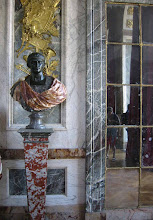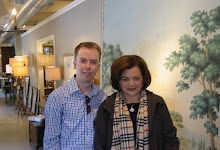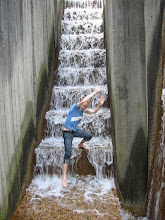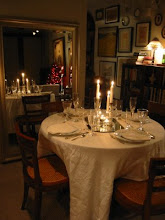 In last week's post on the Pan American Building by Paul Cret, I forgot to post one of the most important pictures! This model shows a cross section through the main space -showing the Beaux Arts diagram of progression of spaces perfectly that I had tried to describe. To the left is the entry hall, you can see the glass canopy over the courtyard next with the stairs beyond. Next at the top of the stairs is the Hall of Heros and last is the piece de resistance, the ballroom with the tallest ceiling (with the library below it). You can tell this is the most important space in the building just from this section and all of the others lead up to it; Sometimes a picture IS worth a thousand words! Have a great weekend!
In last week's post on the Pan American Building by Paul Cret, I forgot to post one of the most important pictures! This model shows a cross section through the main space -showing the Beaux Arts diagram of progression of spaces perfectly that I had tried to describe. To the left is the entry hall, you can see the glass canopy over the courtyard next with the stairs beyond. Next at the top of the stairs is the Hall of Heros and last is the piece de resistance, the ballroom with the tallest ceiling (with the library below it). You can tell this is the most important space in the building just from this section and all of the others lead up to it; Sometimes a picture IS worth a thousand words! Have a great weekend!
Looking Forward
1 hour ago









 Here in the Pan American building, there is a central entry point, the foyer seen above, with a long grand procession up stairs flanking an open courtyard, culminating at the main space, the ballroom.
Here in the Pan American building, there is a central entry point, the foyer seen above, with a long grand procession up stairs flanking an open courtyard, culminating at the main space, the ballroom.  The essential purpose of this building was entertaining. Therefore, the floorplan follows this diagram precisely with all of the other functions such as offices and the library being worked in around this core. The building was designed around guests arriving for a party or lecture in the ballroom.
The essential purpose of this building was entertaining. Therefore, the floorplan follows this diagram precisely with all of the other functions such as offices and the library being worked in around this core. The building was designed around guests arriving for a party or lecture in the ballroom.



 The tree on the left was actually planted by President Taft at the opening of the building: grafting together two species of trees, one from South and the other from North America.
The tree on the left was actually planted by President Taft at the opening of the building: grafting together two species of trees, one from South and the other from North America. The fabulous central marble fountain was sculpted by Gertrude Vanderbilt Whitney and features Aztec figures with eyes which light up!
The fabulous central marble fountain was sculpted by Gertrude Vanderbilt Whitney and features Aztec figures with eyes which light up!
 More of the beautiful glazed terracotta work below depicting maps of the Americas and doves of peace: Peace being the organization's mission.
More of the beautiful glazed terracotta work below depicting maps of the Americas and doves of peace: Peace being the organization's mission. Below you can see the glass roof over the terracotta tiles.
Below you can see the glass roof over the terracotta tiles. The polychrome wood brackets are really stunning and add a lot of color to the terracotta and beige plaster.
The polychrome wood brackets are really stunning and add a lot of color to the terracotta and beige plaster. I thought this tiled water fountain, located behind the courtyard was really fantastic!
I thought this tiled water fountain, located behind the courtyard was really fantastic!
 Here we are at the top of the stairs looking down at the foyer. The building opens up even further on the 2nd floor, with office suites opening off the corridors you see running alongside the staircase.
Here we are at the top of the stairs looking down at the foyer. The building opens up even further on the 2nd floor, with office suites opening off the corridors you see running alongside the staircase.  The main hall upstairs is known as the 'Hall of Heros' and is lined with 50 busts which were given by countries in the organization. George Washington was chosen by the US and is located prominently in the center.
The main hall upstairs is known as the 'Hall of Heros' and is lined with 50 busts which were given by countries in the organization. George Washington was chosen by the US and is located prominently in the center. Flags of the members also line the hall.
Flags of the members also line the hall.  The main ballroom, or 'Hall of the Americas', opens off the 'Hall of Heros' through 5 large doorways, mirrored 65feet across by the arched windows to the garden below and is lit by 3 enormous crystal chandeliers. A meeting was in session during our tour.
The main ballroom, or 'Hall of the Americas', opens off the 'Hall of Heros' through 5 large doorways, mirrored 65feet across by the arched windows to the garden below and is lit by 3 enormous crystal chandeliers. A meeting was in session during our tour.



















.jpg)





.jpg)





















.JPG)






































































